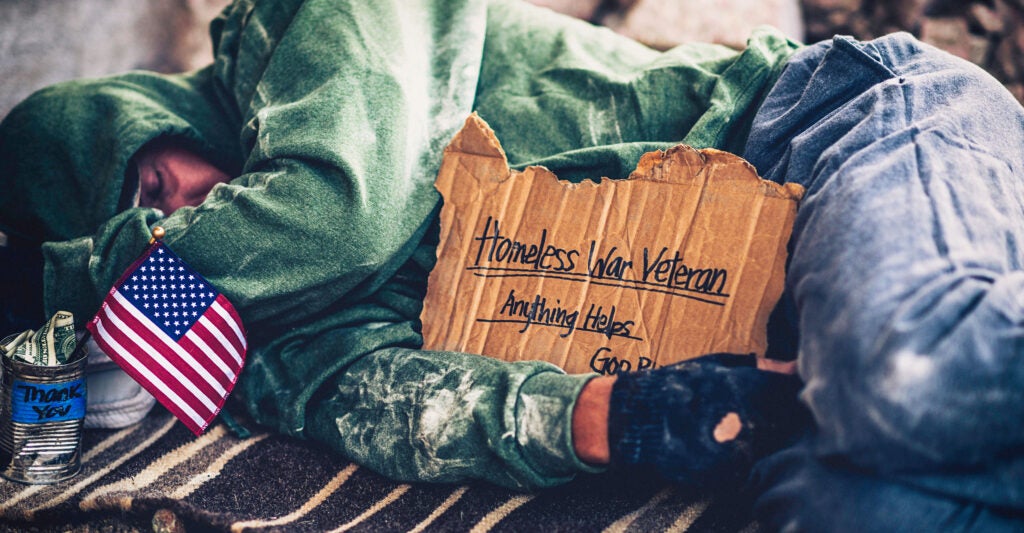Are cities required to allow the homeless to sleep on public property? This month, the Supreme Court is expected to rule in a case that examines whether it’s unconstitutional to impose penalties for street camping.
My colleagues have written about the legal details of the case, explaining that the Constitution does not provide a right to sleep on public property, nor does it include a right to shelter for the homeless.
City governments have the authority to determine how a city’s public property is used.
Of course, local governments are also faced with the challenge of how to help those who do end up on the streets. Cities across the country have seen homelessness rise, but government solutions have been mostly unsuccessful.
So, what’s to be done to help those who languish on the streets?
Number of Homeless
More than 653,000 people were homeless on a given night in 2023, the highest number recorded since the federal government began collecting data in 2007.
Homelessness in the U.S. has been climbing since prior to the COVID-19 pandemic, including both “sheltered homelessness” (the homeless who are staying in shelters) and “unsheltered homelessness” (those residing on the streets or other places not meant for human habitation).
Government spending on homelessness has also been increasing at all levels. In 2017, the federal government spent $7.4 billion on homelessness programs (adjusted for inflation), which jumped to more than $9 billion as of 2024. More spending on homelessness programs is proposed for the upcoming fiscal year.
And this is just a tiny fraction of total government spending on all anti-poverty programs, which currently amounts to more than $1 trillion annually. These 90-plus means-tested programs provide cash, food, housing, medical care, and social services to those with low incomes (or no income).
For nearly two decades, the general approach to homelessness has prioritized providing permanent housing without barriers to entry; that is, no requirements to participate in programs such as for drug rehab, mental health treatment, or job training. But this “housing first” approach does not reduce overall rates of homelessness or improve problems such as drug addiction, mental illness, or unemployment.
Permanent housing is also costly, takes a great deal of time to build, and can be occupied for many years, meaning it isn’t as available for others who might need it.
What Can Be Done?
The underlying causes of homelessness vary, so approaches to helping the homeless should also vary. Sometimes a family might just need temporary rental assistance to get through financial hardship. In other cases, people face severe challenges that can require intensive intervention.
To address homelessness, the government should first stop focusing on “housing first.” Instead, funding should favor programs that improve well-being and self-sufficiency, measured by outcomes such as reduced drug abuse, increased employment, and transitioning people to private housing.
While permanent supportive housing may be appropriate for the direst cases, temporary housing, paired with requirements to participate in programs like drug rehab, mental health treatment, and job training is most optimal.
That approach addresses the need for shelter, but it requires personal accountability and promotes self-reliance.
Treatment for Mental Illness
Cities and states should also make psychiatric care for those with severe mental illness more available. One study estimates that 78% of those living on the streets struggle with a mental health problem. But there’s a major shortage of public psychiatric beds available.
State policymakers should also review their involuntary commitment laws to ensure such laws don’t make it overly restrictive for those with severe mental illness to get treatment. Some individuals present significant harm to themselves or others and may not even be healthy enough to recognize they have a mental illness.
Assisted outpatient treatment is another option states can use to help those with severe mental illness who need supervised care, but don’t necessarily need institutional care. Researchers find that assisted outpatient treatment participants are less likely to become homeless, be arrested, be hospitalized, or use illicit drugs.
Ex-Cons Especially Vulnerable
Former prisoners are at high risk for homelessness, and more than 15% of the prison population have experienced homelessness. Former inmates often face challenges finding housing and employment due to their incarceration record.
Programs that work with ex-prisoners to reintegrate them into the community can help individuals avoid homelessness, not to mention avoid prison recidivism. Hope for Prisoners, a program in Las Vegas, is an example of a program that provides “life skills and leadership training, long-term mentoring, and ongoing support” to the formerly incarcerated.
Strengthening Families
Strong family and community connections are significant protectors against homelessness. Helping people overcome challenges, such as drug abuse, that stand in the way of healthy relationships will help reduce homelessness.
Some cities also have programs to help the homeless reconnect with family they have lost contact with due to strained relationships or lack of steady contact information. San Diego and San Francisco have kinship programs, where volunteers help the homeless find family members and contact them.
Those are just a handful of reforms cities and states can implement to help the homeless. But any solutions to assist should focus on addressing the underlying causes of poverty and building self-reliance and reconnection with the community.
Tent encampments on American streets have become all too common, and city leaders have the responsibility to maintain order on their streets. Coupling policies that protect public order with those that promote self-sufficiency will help increase the well-being of the entire community.
